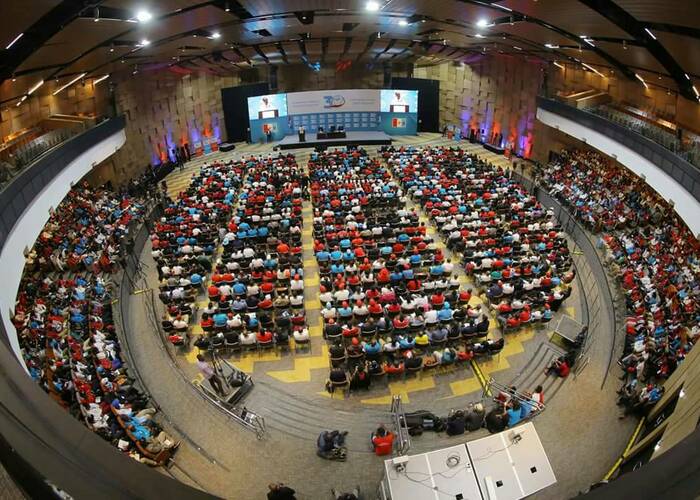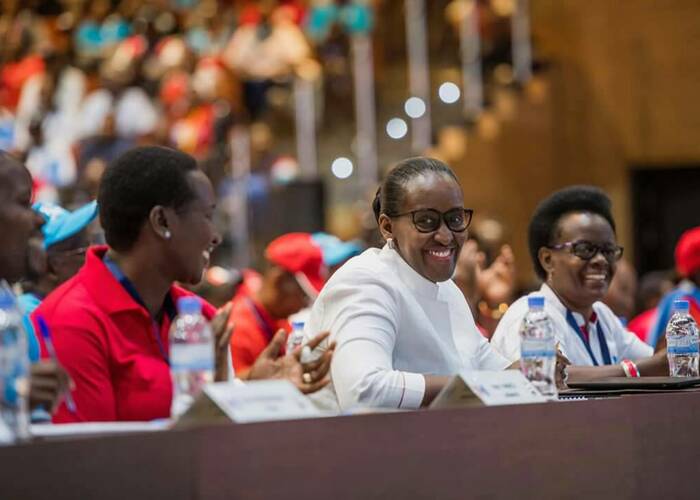RPF marks 30th anniversary
The inauguration of a museum is part of the many activities the Rwandan government is carrying out as the ruling party celebrating its 30 years of existence.
By Hope Mafaranga in Kigali
In most countries including Uganda, one would think that Parliamentary buildings are used as venues for legislating on issues of nation importance.
However the Rwandan Parliamentary building is not only hosting the legislators but also is a home to the newly opened Campaign against Genocide Museum.

The building which hosted the Rwandan Patriotic Front (RPF) politicians and the 600-man protection force (3rd Battalion) in December, 1993 as they were in the preparations for the installation of Broad Based Transitional Government and the National Transitional Assembly, was on Wednesday inaugurated by the president Paul Kagame.
Kagame, who had earlier on witnessed a closed swearing in ceremony of the two new ministers of Education and ICT, commissioned the museum and later toured it.
The inauguration of the museum is part of the many activities the Rwandan government is carrying out as the ruling party celebrating its 30 years of existence.
Senator Tito Rutaremara, one of the RPF core cadres during the inception of the liberation struggle, said the museum will be considered as a center of education in prevention against Genocide.
Rutaremara said the museum will also showcase operations carried out during the campaign against genocide in 1994, without forgetting the major historical periods and iconic artifacts surrounding the Liberation struggle of Rwanda.
He said they decided to put a museum at parliament because the building was used as protection areas duration the 1990-1994 liberation struggle.
Breathtaking
Touring the museum is breathtaking. Pictures and videos inside the museum ranging from the Arusha Peace talks between the RPF and government, the assassination of Rwandan president Juvénal Habyarimana and Burundian president Cyprien Ntaryamira on April 6, 1994 takes you back the genocide day.
Notable in the museum, is what Medard Bashana the museum Manager said is a secret letter named "SAM 16" that was instructing the government soldiers to kill the Tutsi.

A monument on top of the building portraying the two RPF soldiers manning a heavy machine gun which was used to first contain and prevent attempts by the genocide army of the former killer regime to recapture that section of Kigali is also another site to see.
But the most moving images are the sickbay where, RPF soldiers were treating victims of the genocide.
Bashana said the Campaign against Genocide Museum will co-exist with the Kigali Genocide Memorial Center, adding that it will attract more tourists in the country.
Achievements
Rutaremara said after the military struggle, the RPF have establishment the of rule of law, attracting investors in the country and setting out a new path of growth and prosperity.
Rutaremara who also one of the founders of the RPF is positive that by 2020, the country would have defeated the war against poverty, saying the some achievements are already visible especially in regard to national stability which is the key pillar of RPF.
He said people are working towards improving their household income because they have now had an identity and dignity that was lost during the genocide.
"From the 1994 Genocide chaos, we can now boast of tangible peace that have enabled our people to work towards prosperity and I am happy they have embraced the home grown solutions to iron out their difference and above all they have taken the issue of unity and reconciliation to re-build Rwanda," he said.
Memories
"In the night when Habyarimana's plane was shot, the mood was tense," he said. A number of theories, rumors and accusations on who killed Habyarimana, Ntaryamira were internationally spread.
However Rutaremara 79, put this accusation to bed, saying: "As we negotiated to have a joint government, some people in the government were not happy about it.

They were actually not in agreement with what President Habyarimana was doing and opposed the agreement signed in Arusha. It is common sense they gunned it down," he talks about the event as if it just happened yesterday.
According to him, the airplane carrying Habyarimana and Ntaryamira was shot down as it prepared to land in Kigali, Rwanda.
"What happened in the night of the shooting kick started the genocide. The plane also had many high-level Rwandan political and military officials who had accompanied the presidents for the Arusha peace accords meetings," he said.

Mzee Tito Rutaremara
Asked if he has an idea on who exactly killed the presidents, he said that a research was done and found out that the people who were at Kanombe camp shot the plane.
"Research was done with the British experts who proved scientifically that people from the Kanombe camp controlled by government's army, shot down the plane by missiles fired from the ground carrying the two presidents who were coming back home from Tanzania," he said.
He comments related to the "secret letter " Bashana had explained during the tour.
Every year, Rwanda observes the 100 days of genocide between April and July, to remember over one million people who were killed during the genocide.